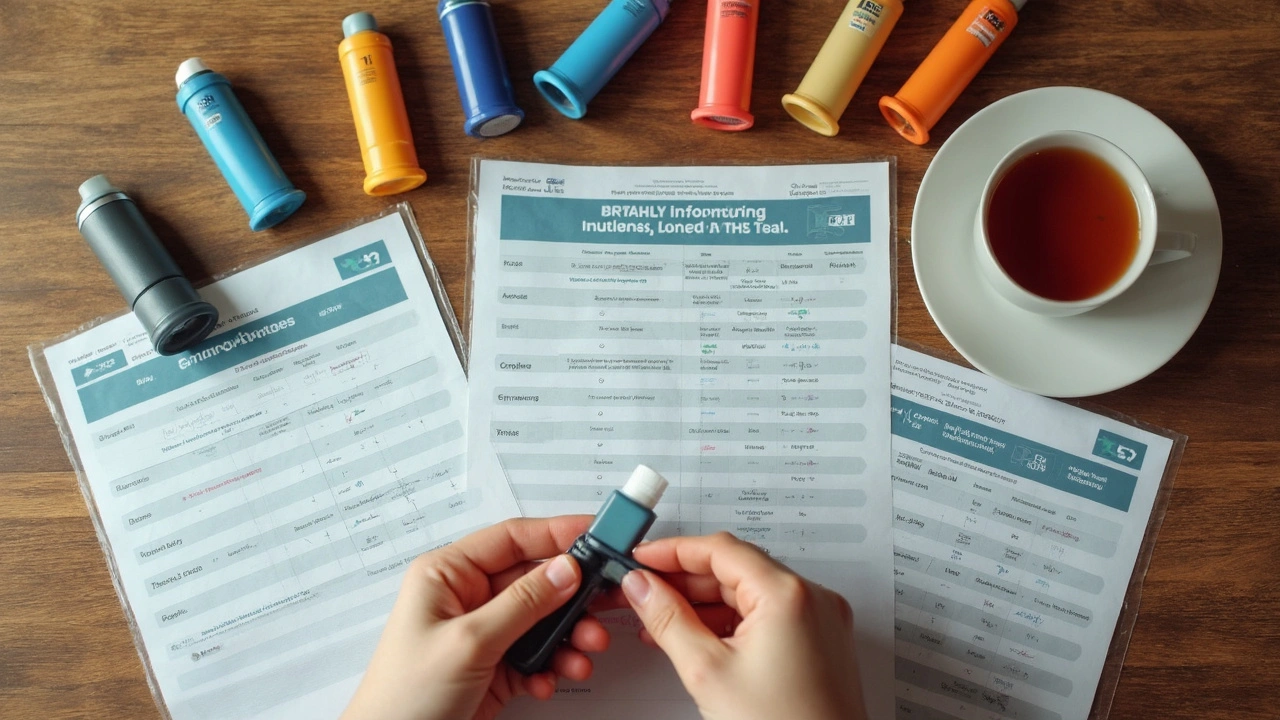Why Look Beyond Anoro Ellipta?
It’s always tempting to stick with what you know, right? But with medications like Anoro Ellipta, sometimes your insurance, your body, or just your personal preferences push you to shop around. Anoro Ellipta has been a trusted weapon for COPD for years, thanks to its unique combo of umeclidinium and vilanterol. Still, breathing better isn’t a one-size-fits-all deal. Some people love the once-a-day dose but hit a wall with side effects, coverage hiccups, or just not feeling as good as they hoped. Besides, the science of COPD meds never sits still—it’s constantly serving up fresh options.
Here's something wild: dual-bronchodilator inhalers first hit pharmacies a bit over a decade ago. Now, new alternatives pop up regularly. Doctors and patients are seeing inhaler choices that can rival or even outdo what Anoro delivers—not just in symptom relief, but also in how well they fit into your daily life. Since your lungs don’t take a break, why should your treatment options? It’s smart to stay on top of what else is out there, especially as research and FDA approvals keep piling up.
And sometimes, insurance plays a bigger role than we’d like. As plans shuffle their preferred meds, even lifelong Anoro users can get nudged toward other inhalers. Wouldn’t it help to know the new front-runners and how they might steer your breath in the right direction?
The Magic Behind Dual-Bronchodilator Therapy
Let’s strip the jargon for a second. Dual-bronchodilator inhalers simply mean two different medicines team up in one puffer. For COPD folks, these usually combine a LABA (long-acting beta-agonist) and a LAMA (long-acting muscarinic antagonist). Think of one as opening up the airways using one pathway and the other relaxing them via a different path—like giving your lungs a tag-team effort to keep them more open, longer. Anoro Ellipta is a LABA/LAMA duo, pairing umeclidinium (LAMA) with vilanterol (LABA).
Why not just use one medicine? Real-life COPD is stubborn. Symptoms—shortness of breath, cough, chest tightness—don’t always play by the rules. The double punch from dual bronchodilators generally keeps airways wider for longer, cuts down rescue inhaler sprints, and can make getting through the day a bit easier. And for some, duals work so well they can stretch the gap between flare-ups, keep hospital runs rare, and maybe even slow disease progression. Studies published in 2022 and 2023 show combo inhalers can reduce moderate-to-severe exacerbations by 24%-37% over single-agent inhalers, depending on the specific combo.
But differences lurk deeper. Not all LABAs or LAMAs act the same. That’s why switching to a different combo can change how often you puff, how quickly you feel relief, or even which side effects tap you on the shoulder. Some inhalers taste different, use another device, or last a different number of hours. Really, it’s not just the ingredients—it’s their chemistry, the device, dosing, and even how your body absorbs them. This is what makes the search for the right alternative, if not downright fun, at least promising. Especially if you’ve tried Anoro and found it lacking in any way.

Meet the New Replacements: What’s Catching Doctors’ Eyes?
So what other inhalers are breathing down Anoro’s neck? Newer dual-therapy inhalers are stealing the scene. Some, like Stiolto Respimat (tiotropium/olodaterol) and Bevespi Aerosphere (glycopyrrolate/formoterol), approach COPD from slightly different angles. They use different LABA and LAMA combos, and for some, the different device style is enough to tip the scales. Stiolto, for example, comes as a mist—people with trouble generating a strong inhale find it gentler than dry powder devices like Ellipta.
Bevespi Aerosphere, meanwhile, employs an older device type—the pressurized metered-dose inhaler. For patients who prefer that classic puffer, or who find dry powders irritating, it’s a handy alternative. Both are dosed twice daily, which can have its pros and cons: more flexible adjustment in daily life, but a little easier to forget compared to once-a-day Anoro. For some, dosing flexibility wins; for others, less is more.
Then there’s Utibron Neohaler (indacaterol/glycopyrrolate), another dual that grabs attention for its strong, quick-onset LABA. While it’s not as widely prescribed as Stiolto or Bevespi, studies show Utibron can boost FEV1—basically, your lungs’ power and capacity—by over 200 mL in certain patients. The Neohaler device is a bit of a learning curve, but the effects on breathlessness win fans fast.
Brodalumab/aclidinium (marketed as Duaklir Pressair), brings yet another flavor, delivering solid results in European COPD studies and now available in the US. Its Pressair device gives visual and audible feedback, handy for anyone worried they’re not using it right. Device comfort, dosing frequency, and side effects can all matter just as much as the actual combination for some people. Trying a few devices—with your doctor’s help—can uncover preferences you didn’t realize you had.
For folks on the hunt for a broader list, there’s a super-detailed breakdown at Anoro Ellipta alternatives. It’s a great resource if you want to see the forest *and* the trees.
Comparing Devices, Dosage, and Effectiveness: The Nitty Gritty
If your routine rides on how and when you use your inhaler, these new choices really matter. Here’s what sets the top alternatives apart:
- Stiolto Respimat: Inhaled as a slow-moving mist, two puffs once daily. The delivery method can be easier if your breath is weak.
- Bevespi Aerosphere: Classic MDI style, two puffs twice daily. No powder dust or need for a forceful inhale.
- Duaklir Pressair: Breath-activated, dry powder, two inhalations twice daily with feedback indicators.
- Utibron Neohaler: Single inhalation twice a day, uses capsules you insert for each dose—great for those who like tactile feedback.
- Incruse Ellipta (umeclidinium only) or Striverdi Respimat (olodaterol only): Not combo, but sometimes stacked with a LABA/LAMA single if insurance demands.
How about side effects? While all these inhalers share the usual suspects—dry mouth, throat irritation, cough—they don’t always show up equally. Some people find Bevespi a bit more forgiving on the throat; others love Stiolto’s lack of powder dust. And none are totally free of risk: the FDA keeps tabs on rare but serious side effects like urinary retention, fast heartbeat, or, in a pinch, paradoxical bronchospasm—an attack of worse breathing right after using the inhaler. Always report anything odd to your care team, and don’t tough it out alone.
The bottom line is, your perfect inhaler match depends on your hands, breath strength, remembering doses, and side-effect tolerance. I’ll never forget watching my father swap devices twice before finally settling on Stiolto. For him, the easy-to-use Respimat mist and fewer mouth problems sealed the deal. For you, maybe it’s something else entirely.

Picking What’s Best: Tips for Patients and Caregivers
You might wonder, “Isn’t my doctor supposed to pick my inhaler?” Sure, but these days, shared decision-making is the game-changer. Your voice counts. If your hand aches, tell your doctor. If powders trigger a gag, speak up! Bringing up even small details can make a huge difference in daily life.
Affordability also matters—a lot. Don’t let sticker shock catch you off guard. Generic alternatives are rolling out for some dual-bronchodilators as patent cliffs arrive. If you’re stuck with a high copay, check manufacturer coupons or patient programs. My wife, Amelia, once spent a whole weekend hunting for online savings cards and snagged us an extra month’s supply. It's detective work, but it pays off.
Staying on top of inhaler technique is clutch. No matter the device, if you’re not using it perfectly, results drop off hard. Your pharmacy or doctor’s office should walk you through a demo. If they don’t, ask! It’s not just you—studies keep finding up to 70% of folks use their inhaler wrong, missing out on full symptom control. YouTube and pharmacy websites now show step-by-step videos, so take advantage.
If you’re feeling stuck between choices, ask to trial a few different inhalers. Some offices keep demo units so you can try the feel and style. Bring up every concern: hand arthritis, eyesight, remembering schedules, cost, taste, or even travel-friendliness. Docs want you to stick with your inhaler, not dread using it.
And routines matter. For many, pairing inhaler use with a set habit—brushing teeth, making coffee—locks in compliance. Keep extras in your car, bag, or at work to cut panic if you forget at home. Caregivers can help here too: a simple phone alarm, chart, or magnet on the fridge takes the guesswork out of schedules.
Your best advocate is you. Don’t be shy about asking for new info, sample inhalers, or deeper explanations. As more Anoro Ellipta alternatives hit the shelves, learning the pros and cons of each can make your COPD journey smoother—and help you find the right fit, not just the first one on the pharmacy’s list.


Rahul Kr
This is a great resource for anyone dealing with COPD and looking for alternatives to Anoro Ellipta. I appreciate the clear breakdown of new drug combinations and the tips on choosing the right inhaler. It's always been a bit confusing to navigate all the options, so having a single article to compare these inhalers is super helpful.
I'm curious, though, how accessible are these newer inhalers in places with less specialized healthcare? Are they widely available or more limited to major hospitals and pharmacies? Also, it would be good to hear some firsthand patient experiences with these alternatives to understand how effective they are in daily use.